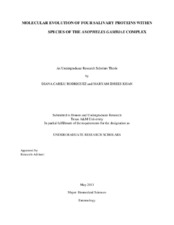| dc.description.abstract | Some of the primary vectors of human malaria include female mosquitoes from the Anopheles gambiae complex, which is comprised of at least six different species within the genus Anopheles, including A. gambiae (M/S forms), A. arabiensis, A. melas, A. bwambae, A. merus, and A. quadriannulatus. Salivary gland proteins within the Anopheles gambiae complex interact with a vertebrate host’s immune system by controlling vasodilatation, inflammation, and platelet aggregation at the feeding site on the vertebrate host. The way certain salivary proteins are expressed within different mosquito species has been studied, but there is still a need for a comparison between species of close proximity, such as those in the A. gambiae complex. This comparison could reveal genes that may interact with a host’s immune system or with malaria parasites and hence may be under selection. Such genes may have crucial roles in the adaptation to specific hosts. For example, an excess of non-synonymous fixed differences in the gene would mean directional or positive selection, which may have resulted from interaction with various hosts. To gain further insight into 4 specific salivary gland proteins (Anophelin, Ichit, Glycosidase, and Lysozyme), their patterns of polymorphism were analyzed in 3 species of the An. gambiae complex (Anopheles gambiae M and S forms, Anopheles melas, and Anopheles arabiensis). After analyzing these genes using several statistical tests, the comparison showed that three of the four genes, Anophelin, Ichit, and Glycosidase are highly conserved with no signs of positive selection or fixed differences between A. gambiae, A. arabiensis, and A. melas species. Further research exploring the genetic variation of other salivary proteins within the A. gambiae complex may identify proteins that are undergoing positive selection. This could locate genes involved in vector competence, either preventing or enhancing disease transmission in Anopheles mosquitoes. | en |


